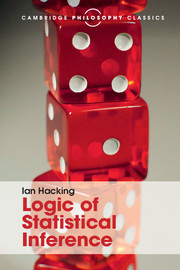Book contents
6 - Statistical tests
Published online by Cambridge University Press: 05 July 2016
Summary
By rejecting a statistical hypothesis I shall mean concluding that it is false. On what statistical data should this be done? Braithwaite thought the matter so crucial that he tried to state the very meaning of ‘probability statements’ in terms of rules for their rejection. We shall examine his ideas later. First we must establish when evidence does justify rejection. To do so, it need not entail that the hypothesis is false. But what relations must it bear to the hypothesis?
Perhaps rejection covers two distinct topics. There have been many debates on this point, and it cannot be settled before further analysis. But a warning may be useful. An hypothesis may be rejected because of the evidence against it. This is my main subject. But situations can arise in which it is wise to reject an hypothesis even though there is little evidence against it. Suppose a great many hypotheses are under test. A good strategy for testing is one which rejects as many false and as few true hypotheses as possible. The best strategy might occasionally entail rejecting hypotheses even though there is little evidence against them. This sounds implausible, but examples will be given.
There is no general agreement on whether rejection should be studied in terms of evidence or strategies. I do not want to prejudge the issue. But I shall begin with examples in which an hypothesis should be rejected because of the evidence against it. I shall not begin with examples in which a great many similar hypotheses are under test. The logic of the two may be the same, for all that has been proved. But I shall not begin by assuming it.
The forthcoming discussion is, as usual, very academic. It concerns the relation of statistical hypotheses to statistical data. Generally one has all sorts of data bearing on an interesting statistical hypothesis, far more than merely statistical data. Hence one's problem is generally more complex than any to be discussed in this chapter. Here I deal only with data which may be precisely evaluated, and whose evaluation is peculiar to statistics.
- Type
- Chapter
- Information
- Logic of Statistical Inference , pp. 67 - 80Publisher: Cambridge University PressPrint publication year: 2016

